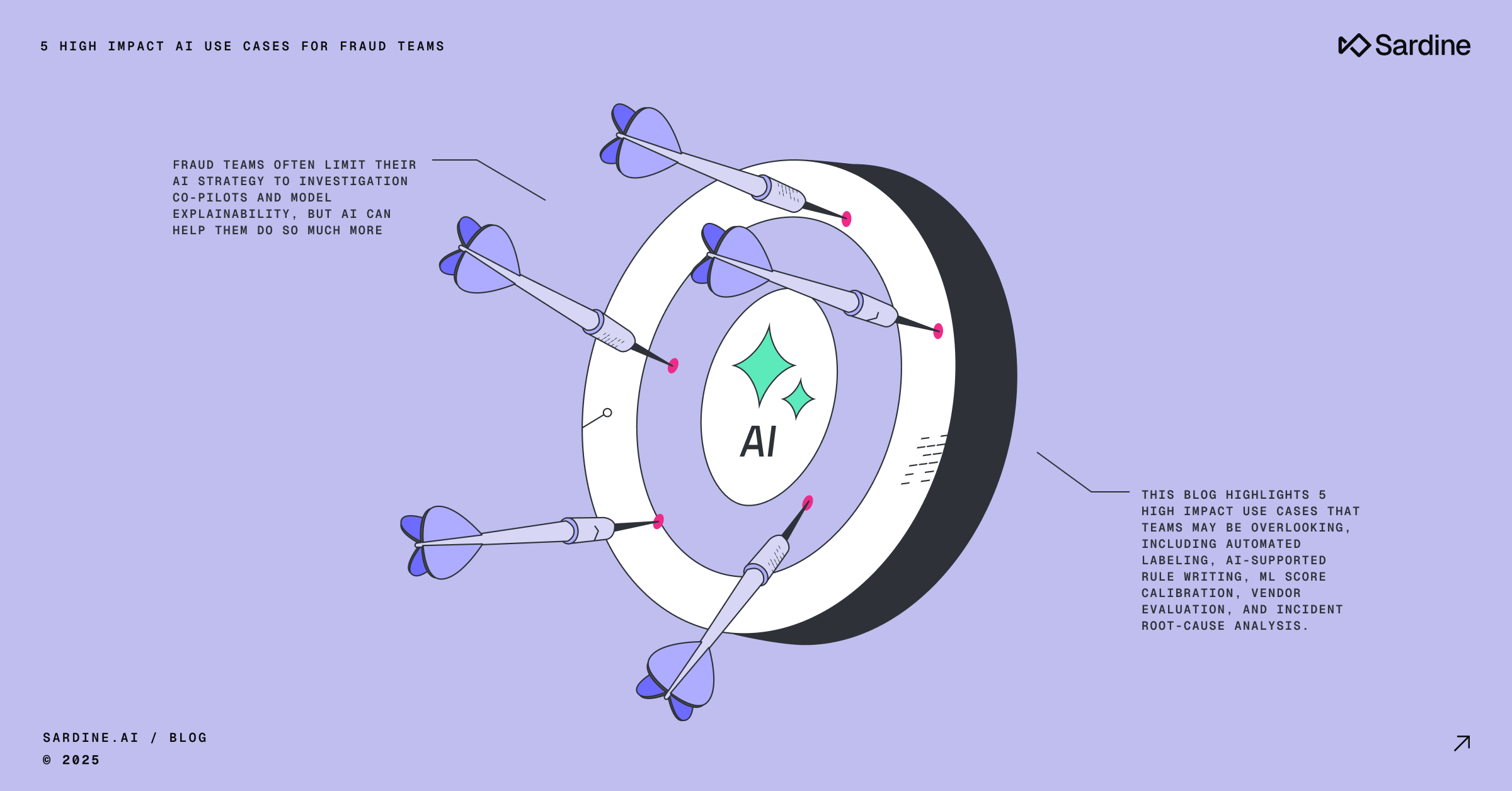Future of Payments: AI Agents in Banking
Are We Ready for AI Agents to Automate Payments?
AI agents are the hottest trend in banking right now, offering massive productivity gains by automating complex tasks and making decisions at lightning speed – tasks that once required human oversight.
It sounds great… who wouldn't want faster, more efficient payments. But are we ready to let AI agents handle our payments, at home and at work, without any humans in the loop?
The allure of having an army of AI workers taking over the tasks that bog down your teams is undeniable, yet, it brings challenges that we need to tackle head-on — especially when it comes to infrastructure, security, fraud, and compliance.
- How do you know the AI Agent is operating within your consent?
- How do you link each payment back to a verified identity?
- How do we prevent fraud against the agents or prevent the agents from committing fraud?
In this blog, I’m going to outline the potential risks we need to account for and explore how, with everyone’s involvement, utilities like Sonar can tackle these challenges.
What Exactly Is an AI Agent?
AI agents are advanced software tools designed to take on tasks that typically require human judgment, especially when those tasks involve making decisions based on real-time data.
They're already making waves in financial services:
- Investment Analysis. Agents can review real-time market data and update internal models or presentations to drive buy / sell / hold investment decisions.
- Loan Origination. Agents can manage complex customer emails, PDFs and communication automatically for SMB lending.
- Disputing Chargebacks. Agents help merchants dispute chargebacks by gathering compelling evidence and submitting it to payment service providers.
- Risk Assessment. Agents help bank operations teams in processes like KYC (Know Your Customer) and AML (Anti-Money Laundering) checks.
For fraud and compliance leaders, AI agents represent a new way to solve problems that were once limited by time, resources, and scale.
So far these use cases have not focused on payments, but for agents to become economically active, they must inform or be able to make a payment directly.
How would AI-Agent payments work?
AI-agent payments could reshape how both consumers and businesses handle transactions, automating everything from routine payments to complex negotiations. Let’s look at a few examples of how AI agent payments could work:
- Consumer agents. Can help switch utility providers to the best rate and set up recurring payments on your behalf, or switch your savings or investments for better returns.
- Business agents. Negotiate with suppliers to find the best price and manage the invoicing, payment and payouts.
- Agent to agent commerce. Where an agent can provide a service like language transaction to another AI agent, without human intervention.
These new forms of commerce offer significant potential, but as with every wave of innovation in payment systems, it won’t come without risks.
Today's payments market is increasingly complex, with more payment networks, wallets, and providers emerging both domestically and internationally. This creates more places for bad actors to hide in the shadows and exploit blind spots. AI agents have the potential to eliminate these vulnerabilities and strengthen security across the system.
So, What's Holding Us Back from AI Payments?
Initiating payments through systems like ACH, wire transfers, card networks, or real-time payments (RTP) isn't just about speed—it's about security, trust, and control.
There are five key focus areas to bring this security and trust.
- Unified Consent Management
- Real-time identity and transaction verification
- Significantly more advanced fraud controls
- Dynamic transaction approval
- Interoperability across payment rails

1. Unified Consent Management
We need a centralized system where you can specify transaction limits, approved recipients, and rules for different payment types. Without this, there's a risk of unauthorized transactions slipping through. How will a business or consumer create that consent, and how will it be enforced?
2. Real-Time Identity and Transaction Verification
Each transaction initiated by an AI agent must be securely linked to you, the human owner. Using encrypted tokens or digital certificates can help, and for larger transactions, adding biometric verification like facial recognition adds an extra layer of protection. How will agents verify transactions, and how will humans or businesses verify them?
3. Advanced Fraud Detection and Prevention
We can't ignore the potential for fraud. Systems must monitor transactions in real-time, ensuring:
- The AI agent's permissions are intact.
- The trust relationship between you and your AI agent hasn't been compromised.
If something seems off, the system should halt the transaction immediately.
4. Dynamic Transaction Approval and Customizable Rules
You should be able to set rules for your AI agent—like approving monthly bill payments but requiring your nod for larger expenses. This way, routine tasks are automated, but you remain in control where it matters.
5. Cross-Rail Integration and Interoperability
AI agents need to interact across various payment systems—like ACH (Automated Clearing House), wire transfers, card networks, and real-time payments (RTP). Currently, these payment rails often operate in silos with limited interoperability, making it challenging for AI agents to function effectively across them.
Interoperability between rails and identities unlocks AI Agents
The Lack of Interoperability
Each payment rail has its own protocols, processing times, fees, and limitations:
- ACH: Used for direct deposits and bill payments, with processing times typically ranging from one to two business days.
- Wire Transfers: Ideal for large, urgent transfers, often settled within hours but come with higher fees.
- Card Networks: Facilitate instant payments but may involve higher transaction fees, commonly used for consumer purchases.
- Real-Time Payments (RTP): Enable immediate fund transfers 24/7, but adoption varies, and not all banks participate.
This fragmentation means that an AI agent can't seamlessly initiate a payment across different rails based on specific requirements like cost efficiency, speed, or transaction size.
There’s also no single representation of a user, human, or agent that connects these payment rails. If AI agents are to fulfill their promise, their identity, and that of the person or business they’re acting on behalf of, they need to follow them across rails.
The Need for a Common Infrastructure
We need a unified infrastructure that allows AI agents to:
- Select the optimal payment rail: Based on your preferences for speed, cost, and other specific requirements.
- Operate across allsystems: Enabling AI agents to initiate payments regardless of the rail, ensuring the most efficient route is chosen every time.
- Ensure timely and cost-efficient transactions: Balancing the need for rapid transfers with cost considerations, optimizing each transaction according to your needs.
Risk Assessment - Why It Matters
For AI agents to truly enhance payment automation, they must manage different payment systems' nuances.
Your agent should be able to pick the right payment that maximizes your rewards, savings or benefits, just as you would, if you had the time.
We need a common risk infrastructure for agents, AI and payments more broadly.
- Enhanced flexibility: Allowing AI agents to choose the best payment method for each situation without manual intervention.
- Improved efficiency: Reducing delays and extra costs by selecting the most appropriate rail.
- Better Use experience: Providing a seamless service where transactions happen smoothly, quickly, and cost-effectively, without you needing to understand the intricacies of each payment system.
Enter Joinsonar.com: Building the Common Payment Infrastructure
This is where Sonar comes into play.
Sonar has developed cross-rail infrastructure to assess the risk of transactions and counterparties across different payment systems. While it currently focuses on risk assessment, the platform provides a solid foundation to build upon for enabling AI-driven payments.
Facilitating Cross-Rail Integration
Sonar's cross-rail capabilities position it uniquely to address the interoperability challenge:
- Unified access to multiple payment rails: Sonar can enable wallets, institutions, merchants, and, yes, AI agents to interact with ACH, wire transfers, card networks, and RTP through a single platform.
- Risk assessment across systems: By providing consistent risk assessments across all payment rails, AI agents can make informed decisions about which rail to use for each transaction.
- Timely and cost-efficient transactions: With insights into the characteristics of each rail, AI agents can optimize for speed and cost, aligning with your preferences.
The AI agent can optimize your payments like a team of pros would if it had the infrastructure to operate safely and soundly.
Unlocking interoperability between payment rails.
Today Sonar is breaking down the barriers between different systems, and creating a single view of risk, transactions and identity across institutions, wallets and merchants..
Building the Future of AI Payments
In a world where every individual and company has 10s or 100s of agents buying, selling and making financial transactions on their behalf we unlock incredible new economic opportunities.
But in the highly regulated world of finance and payments we won’t get that future unless we build an infrastructure to enable agents to perform commerce.
By expanding on platforms like Sonar's, we can address the key challenges of automating payments via AI agents. This includes:
- Creating robust Ssstems for user Ccnsent and control: Ensuring you can define how your AI agents operate.
- Ensuring real-time verification of identities and transactions: Maintaining security and trust in every transaction.
- Developing advanced fraud detection to maintain trust: Proactively identifying and mitigating fraudulent activities.
- Allowing Customization for User Preferences: Giving you the flexibility to set rules and parameters that fit your needs.
- Integrating across payment systems for seamless functionality: Breaking down silos between ACH, wire transfers, card networks, and RTP, enabling AI agents to initiate payments based on any set of requirements from you in a timely and cost-efficient manner.
Final thoughts on AI Agents in Payments
AI agents have the potential to revolutionize how we handle payments, offering convenience and efficiency like never before. However, realizing this potential requires building and enhancing the necessary infrastructure to ensure these AI agents operate safely, responsibly, and with the trust of everyone involved.
Sonar is leading the way by breaking down barriers between payment systems and creating that foundation. If these issues matter to you and you want to be part of the solution, I invite you to join Sonar and apply to become a member.



%20(1).png)



.png)




